
|
Note ye ed's email address: stevebryant99@gmail.com. Finally unearthed: The Little Egypt Book of Ghosts from H&R Magic Books. |

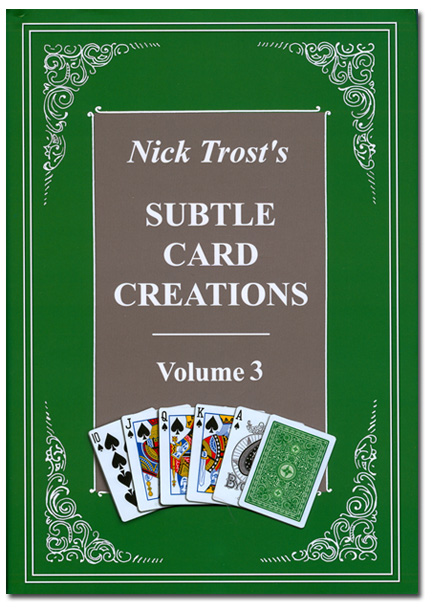
The green edition.
|
April 2011 April showers, desist! As I type, my Little Egypt home town faces the worst flood threat since 1937, and residents are moving their belongings to higher ground in neighboring communities. Enough, already. Magic-wise, April has also provided a flood of products and experiences, far more than I had expected when the month began. To it, then, with a look at Nick Trost's Subtle Card Creations Volume 3; at John Bannon's excellent Bullet Party; at Steve Beam's first bound volume of The Trapdoor; at Patrick G. Redford's oh-so-perfect pass, lecture, and comic book; and at a quite wonderful Central Illinois Magic Get-together in the Land of Lincoln. All this, and May is just around the corner with promises of the new Berglas book and a Magic Collectors Association weekend. Life is good. Wet, but good. |
|
|
OHIO STATEMENT -- When I was a student at the University of Illinois, we quipped that we were good students because winter socked us in and there was nothing to do but study. Perhaps it is the same over in Ohio; for some, there was nothing to do but invent card tricks. As of this month, Ohio State alumnus Nick Trost's incredible legacy continues with Nick Trost's Subtle Card Creations Volume 3, from H&R Magic Books. To borrow a few words from my previous Trost review, H&R Magic Books began publishing a new series of Nick Trost magic in 2008, titled Nick Trost's Subtle Card Creations, drawing on 21 notebooks of Trost innovations. Volume 1 contained 11 chapters along with a 51-page appendix on all the important moves, shuffles, counts, and cuts you might need to tackle most modern and ancient card problems. The series is handsomely laid out, with vintage decorative illustrations at the start of each chapter and the tricks themselves copiously and competently illustrated by Tony Dunn. Volume 2 appeared in 2009 with chapters 12-22, and Volume 3 is now at hand extending the work to chapters 23-34. The new contents cover Further Coincidences, You Do As I Do, The Royal Marriages, Further Gambling Tricks, More Poker Deals, Revealments, Reversed Card Effects, Further Transpositions, Special Decks - Part 2, Packet Tricks Part 3, ESP Cards Part 3, and Computer Cards. The foreword is quite special having been written by Martin Gardner. 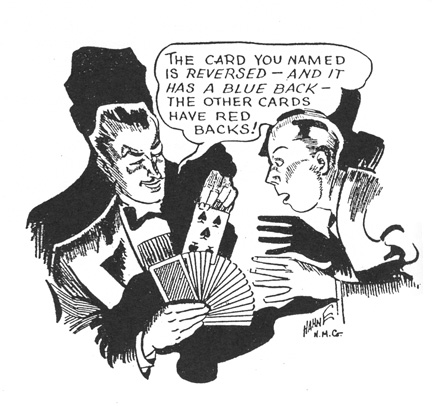 Illustration for chapter 29, Reversed Card Effects. A quick skim of the material easily isolated a number of must-perform items (basic text is straight out of the book; parenthetical additions are my own thoughts): 1. Zens Poker Deal, Redealt: A spectator names any kind of poker deal from a pair to a royal flush. Assume he wants a full house. The performer shuffles the deck and deals five hands. He now asks the spectator which hand should receive the full house, hand No. 1, 2, 3, 4, or 5. Say the spectator selects hand No. 3; the performer marks this position with a poker chip. The five hands are gathered, the deck is cut and five more hands are dealt. The performer shows that hand No. 3 is a full house (the called-for hand), which ended up at the position named. (This is so easy. If you can cut the cards, you can do this routine.) 2. High-card Poker Deal, Revised: The deck is shuffled, and then the high cards are removed for a poker deal. These cards are cut in half, the halves ribbon spread on the table, and then the spreads are pushed together, interlacing the cards. (The shuffle is very convincing.) A spectator deals five poker hands, but they are just average. The cards are gathered and cut, and the performer deals five more hands, the fifth to himself. Each of the first four hands is a 10, J, Q, K, and A -- a straight. The performer's hand is the winning one -- four nines. (Note that initial shuffle, and also that the end result would get a lot of money onto the table. This is a really fine self-working routine. It's followed by a Steve Forte version.) 3. Shuffle Tracking: The performer patters about a system of "shuffle tracking" used by gamblers to keep track of cards in a game of poker. He uses half of a deck, shuffles it and then deals five hands of poker, shuffle tracking a full house for himself. The cards are gathered and cut by a spectator any number of times, and then the performer explains he will mix them in a special way by dealing them into two, three, four, six, seven or eight piles, whatever number is selected by the spectator. This mixing process is carried out any number of times. Finally, the performer deals five poker hands, the fifth to himself. The other players get Aces and eights (Dead Man's Hand), a nine-to-five straight (Office Hours), four deuces (quadruplets), and fives and tens (a Woolworth), while the performer wins with a royal flush. (I just love the patter on this one. Self working; picking up the piles is especially fun if seven are dealt.) 4. Significator Cards: A spectator selects a card under absolutely fair conditions and loses it in the deck. All this is done while the performer's back is turned. The deck is spread on the table, and the spectator pushes out four face-down cards. Using these four cards as "significators," the performer reveals the selected card. (This is one of two tricks cited by Martin Gardner as special, and it is the trick Charlie Randall used to fool Marshall Petersen. I love it because it has a Trick That Cannot Be Explained aspect, fun to do.) 5. Al Thatcher's "Affinity Cards": Spectator A thinks of any number from 1 to 10 and notes the card at his number in the deck. Spectator B thinks of a number from 11 to 20 and notes the card at his number. The performer takes the deck behind his back, makes an adjustment and then brings it forward. The two cards now at the spectators' numbers are laid aside. They are not the selected ones. The two cards laid aside -- "affinity cards"-- are placed face up in the deck at spots designated by the two spectators. The deck is spread, and the cards directly next to the affinity cards are found to be the selected ones. (This is the second trick cited by Martin Gardner as special. I love it because of Trost's patter line: "These are not your cards, but they have an affinity with your cards--they occupy the same positions in the deck as your cards did originally." Rock solid Ohio logic.) 6. Oscar: A spectator thinks of any card in the deck. The performer says he will name the card, so he names it "Oscar." The spectator thinks it's a gag until the performer shows different names--such as Al, Henry, Bert, and so on--printed on the back of each card. The spectator's thought-of card is turned over, and it does say Oscar on it. (This was Trost's bestselling marketed version of the Fred trick, featuring the use of only one deck and no rough-smooth. It's easy to make up and ideal for using Eugene Burger's idea of having the card bear the spectator's name.) As usual, an excellent book of original, subtle card mysteries, 292 pages, hardback, $45 from H&R Magic Books. | |
|
BANG, YOU'RE DEAD -- I prize all John Bannon books, and Bullet Party is no exception. John is bored of such ruses as Braue additions and ATFUS, and so seeks more direct, efficient, and novel modus operandi. He succeeds, time and again, with methods that are especially sneaky, satisfying, and well within my range. Bullet Party's arsenal of 13 titled items includes a clip full of new ace assemblies along with outstanding revelations, moves, and more. Drop Target Aces allows you to bury aces repeatedly, dribbling cards atop them each time, until only four cards remain--the aces. Flipside Aces allows you to prove the aces are buried amongst the indifferent cards, until you reveal that they were separate all along. Box Jumper updates a recently popular Simon Aronson trick, allowing a chosen card to transpose with a memorable boxed card; key to the method is a dead-easy new Convincing Control. Fat City Revisited is a two-phase sandwich effect; both its "normal" opening phase and its most offbeat second phase feature new techniques and the freedom to tell the audience what you are going to do just before you do it. But my favorite is Question Zero: from a shuffled deck, a spectator merely thinks of one of five truly random cards, all five are lost in the deck (even the spec has no idea in which order the five were returned), and yet the magician locates the selection. Bullet Party is tremendous fun to work through, and I look forward to aiming its contents at my friends. |
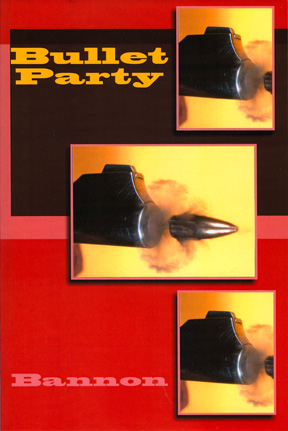 Ka-pow!. |
|
Note that I purchased the book ($20 from Vanishing Inc.). I had the good fortune to see the title effect, Bullet Party, performed by Caleb Wiles, who learned it from the DVD ($40, with different material). Both book and dvd are of course also available from johnbannonmagic.com. | |
|
TIME CAPSULE -- I've no idea how I missed out, way back in 1983, when Steve Beam began his one-man labor of love pasting up issues of The Trapdoor, the old fashioned way, with scissors and glue. Any magazine full of easy-to-do miracles afloat in a sea of good humor should have been my cup of tea. (Block that metaphor!) Fortunately, I am in the midst of catching up, thanks to Steve's having published a bound edition of the first 25 issues (1984-1988). Two more bound volumes will follow. Having skimmed this handsome tome over the past 48 hours, here are a few observations. The material, with the usual high incidence of card tricks (but with such unusual tricks as the appearance of a tee shirt over your previously nude torso, an effect I'd rather see Melinda do than Steve Beam, just sayin'), is first rate. Prominent contributors over these first 25 issues included Steve Beam, Wayne Kyzer, Dexter Cleveland, and John Riggs. John in particular stands out: I previously knew his work through his contributions to mentalism, but here is a wide variety of input, not the least of which is in the area of humor. John quickly ascended to the post of Staff Cartoonist, and his many bits with Mr. Jimmy evolved into the best known routine to emerge from these pages. 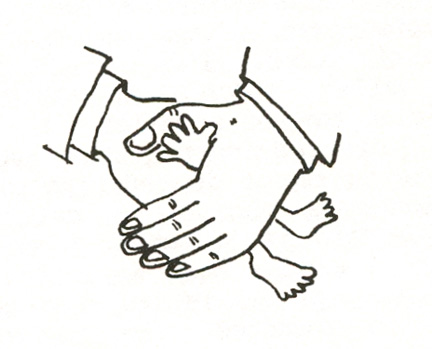 Mr. Jimmy comes to life. A few items are dated--there are effects involving the old computer language BASIC, and Time Bomb, frightening in its day, would be terrifying post-911--but most are timeless. Steve Beam performed Upside Down, from the first issue, at the launch party for The James File to a standing ovation. But whether you read it because you are still searching for that one card trick that will make you famous or because you just love reading magic magazines, you are going to have a good time because of Steve's ever present sense of humor. True, there are special issues of technical merit such as the John Riggs and Tom Gagnon one-man issues, but there are also the Dead Raccoon issue and the Bald issue. Some routines contain gags you can perform, some are pure gags that you can't, and some are in between (e.g. Bird Brain -- The Use of Doves in Mentalism). In his Subscriptions column, Steve took hilarious potshots at the competing magazines of the day, and I trust his fellow editors laughed as much as he did. A sample: And The New Tops? What are you paying for other than the articles and a wonderful production job? That's right. Ed Marlo's fifteenth version of something. Who is this guy? If he didn't like the first fourteen versions, why did he publish them? I think he was the guy who asked David Devant how many tricks he knew. Devant replied, " I should say, I only know eight." Ed spit on his shoes. "Eight tricks and you call yourself a magician?" The Trapdoor is 510 oversized page, multiply indexed (issue by issue, contributor by contributor, trick by trick) with full retrospective commentary by Steve Beam on each issue. Fun, fun, fun, $90 from Steve Beam. | |
|
|
PASS PERFECT -- It's hard to believe anyone could be burned at the stake over a card move, but that's the vibe I got over at the Genii forum when Patrick G. Redford posted a video on Youtube of Dan Fishman's Dribble Pass. The oh so clean sleight offended some as being Too Perfect, with cries of video fakery and denials of wrongdoing by Mr. Redford. Whatever, at the height of the shouting (irate typing?), I wasn't about to miss a Patrick G. Redford lecture in Indianapolis, hosted by Caleb Wiles, and I am glad I didn't. Three reasons. First, I hadn't socialized with the Indy magicians in quite awhile, and it was fun to mix it up with them again. As usual, Caleb had some clever and quite funny items to show me. Second, it was an excellent lecture, with Patrick (aka George Tait) demonstrating a number of clever and doable effects that revolved around the theme of perspective, a cousin of multiple outs in which the way the drama plays out seems to the spectators to be the only way it could play out. One of the items he taught, 30 Card Poker, was a killer three-phase Mexican poker routine, with three banks of ten cards. I mention this as a segue into the third reason: acquiring a copy of Patrick's booklet Square, part of his "shape" collection of magical comic books that began with Triangle (reviewed here in July 2007). 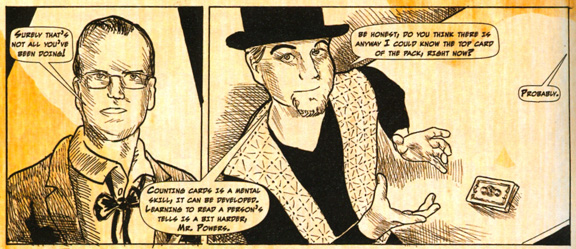 Patrick confounds Mike Powers. In comic book format, Square contains only four card tricks, but what tricks. Card Counter is a clever way to first clock a deck yourself (devilishly easily) and then to have the spectator apparently do so himself. Spot Poker Tells, my favorite, is a single card revelation that borders on the impossible, utilizing what most of you know as Simon Aronson's Undo Principle, also developed by Mike Powers. ESP Cards is a five-card ESP matching demonstration, and 30 Card Poker is the highly entertaining poker demo already mentioned. The book is great fun to read as it is laid out like a comic book, with Patrick in the old West performing these tricks for characters you know, such as Max Maven and Mac King and Karrell Fox and Kreskin, etc. Hence, you get to see each trick dramatized before it is explained. There is also some very funny stuff here. $40 may seem like a lot for four card tricks, but these are card tricks you will use. And oh, yes. Patrick demonstrated the infamous Dribble Pass. Perfectly. (The original video went back to TSD-only status, but you can find a version shot by Caleb Wiles online.) |
|
|
THE DOCTOR IS IN -- The Central Illinois Magic Get-Together, which calls itself the greatest one-day magic convention in the world, rotates annually between Peoria, Champaign, and Springfield, Illinois. This year it was Springfield's turn, and thanks to the hard work of the Ring 239 crew and a first-rate lineup, it arguably lived up to its boast. Highlights: Performance and lecture by Jimmy "Cards" Molinari. A most congenial fellow, Jimmy was once part of Marlo's inner circle, and you could see why. He thrilled us with shuffling and culling demonstrations, fried us with card tricks, and taught us stuff even we would do. I loved his Shuffle Cull, his Marlo's Vanishing 11, his Ace Quickie, and his blackjack finale to Marlo's Miracle Aces. Some of Jimmy's routines were dead easy, others hard enough to make us laugh in disbelief. Performance and lecture by Nathan Kranzo. Nathan, looking young and hip in distressed jeans and distressed hair, is a very funny performer with a refreshingly original, edgy sense of humor. His show included a hysterical bit with a balloon and a killer Ring in Lemon; his lecture included a funny Heads or Tails, a magical Three-fly, a great torn newspaper word force and, of course, Mene Tekel ideas. 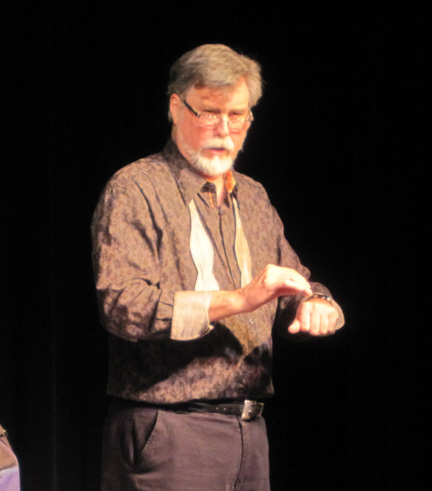 Doc Eason shares his secrets. Workshop, closeup show, lecture, emcee turns, and general good fellowship by Doc Eason. Doc was the BIG name on the bill and didn't disappoint. He kicked off the convention with a night-before workshop, including his marathon Card Under Drink and Fusillade routines. (During all this I learned the best way to do the Slop Shuffle.) Doc's closeup show included Mind Reading Rabbit, Kate and Edith, a new card matching effect, and a strong Fusillade. It's incredible that Doc can find all the cards and remember everyone's name. The lecture featured All Screwed Up, his Copper-Silver-Brass routine, Anniversary Waltz, and Fusillade, all amid the wit and wisdom one picks up after nearly three decades at the Tower Restaurant. 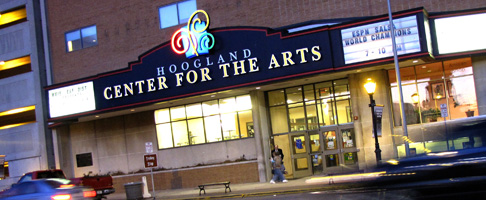 A perfect showplace. The Big Show: You've all been to the "big" evening show at one-day conventions and, frankly, many leave a lot to be desired. Not so at this year's An Evening of Magic that would have thrilled even seasoned It's Magic audiences out in Hollywood. First, the venue was first-rate. Springfield's Hoogland Center for the Arts is an 80,000 square-foot facility that features a 455-seat theater (one of three) that was sold out for the evening performance. Second, the cast was equally first-rate, with strong showings from everyone involved. Doc Eason emceed with Will Rogers ease, and by opening with a card trick that not only got the audience loudly involved but which fried every magician in the room. Throughout, Doc kept the show moving nicely and, later, in the second half, performed the Linking Coat Hangers. Jade (did I mention there were A-list magicians on this show?) opened with a Three-Ring Linking Ring routine, a Cut and Restored Streamer, and an incredible stunt in which she enabled two females and two males from the audience to lift a really heavy third male into the air using only their fingertips. Tony Dowell, a local magician, followed with his bird act. Given "local" expectations, I envisioned an inferior Lance Burton/Channing Pollock clone. Instead, Tony pleasantly surprised me with a modern urban look, unexpected dove productions, and a unique final vanish. Rick Fisher closed the first half with his belching, insulting rabbit puppet, Riley, and I can't imagine a better act for this show. Rick had the kids in the audience screaming with laughter throughout his act, an act he later told us that he hasn't changed all that much since junior high school. The laughs picked up again after intermission under the direction of Tom Burgoon, who held the audience in the palm of his hand with Spoons hanging from a kid, a card trick with flies, juggling metal cups, and Timmy Toilet Paper. I've seen Tom many times, but this was my first time seeing what he could do with a lay audience. It's humbling. Next, an act I really wanted to see, having grown up on Saturday matinees featuring Lash Larue and Whip Wilson. Bullwhip artist Chris Camp grew up on Indiana Jones movies, and it showed in his bullwhip routines with his three kids and his wife. The highlight was Big Momma, a 30-foot long whip whose crack could be felt by the spectators in the first few rows. Impressive. Jade returned to close the show with Rice Bowls and Snowstorm in China. A lovely finish to a public show that was an incredible credit to magic. Kudos to the backstage crew who moved everything along without a hitch. Aftermath: a cluster of magicians including headliners Jimmy Molinari and Doc Eason adjourned to the bar in the President Abraham Lincoln Hotel for late night card tricks and ordered-in pizza. Doc and I bowed out just after midnight, and I've no idea how long the "one-day" convention really lasted. Overall, huge thanks to Jeff Harpring, Eldon Roark, and all the other guys at Ring 239 who helped mount this fine weekend. Which reminds me: As fine as the magic was at the Hoogland, the best magic in Springfield was occurring a few blocks away, at the Abraham Lincoln Museum. The museum features two outstanding walk-through exhibits, one on Lincoln's early life, one on his White House and Civil War years, along with two theatrical presentations, Lincoln's Eyes and Ghosts of the Library. The latter, presented by ATT, is a Disney-worthy E ticket ride featuring the magic of Holavision, a proprietary BRC Imagination Arts technology. Although magicians will recognize a strong Pepper's Ghost element to the technology, there were aspects that definitely fooled us. Highlights included a quill rising from a desk and writing the Gettysburg Address in Lincoln's handwriting as Lincoln's ghost hovered in air in full 3D, and later the fading away of the onstage actor-host. The special effects were amazing, and Disney's Haunted Mansion must be very jealous. Check Ghosts for additional details. |
|
Happy Mother's Day.
Little Egypt Magic is the erratically updated web site of Steve Bryant, spawned (the site, not Steve) by a former internet magazine known as The Little Egypt Gazette/for magicians only. Steve Bryant is an obscure magician and writer who generates this site from an iMac in Bloomington, Indiana. He frequently journeys to and performs magic in Little Egypt, the local name for extreme southern Illinois, where the towns bear such names as Cairo, Thebes, and Karnak. Past issues of this web site: Index to Past Issues Notice: Any limited use of copyrighted images or quoted text is considered fair use, usually to review whatever product or event that is under discussion. If you object to use of any material, please get in touch and it will be cheerfully removed. |
A JSB Creations product
Copyright© 2011 by Steve Bryant